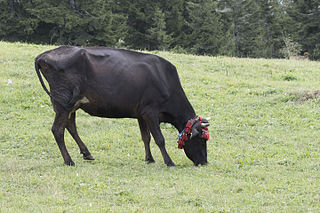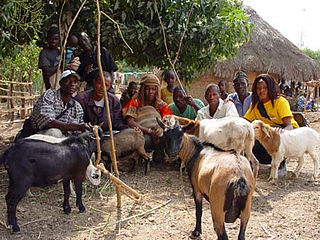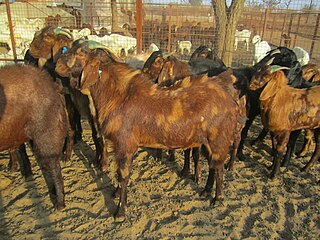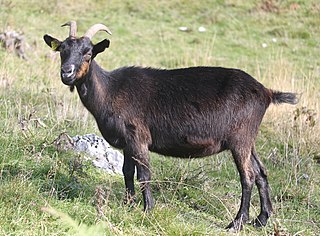Related Research Articles

The dromedary, also known as the dromedary camel, Arabian camel, or one-humped camel, is a large even-toed ungulate, of the genus Camelus, with one hump on its back.

The Nigerian Dwarf is an American breed of dwarf goat. Like the American Pygmy Goat, it derives from the West African Dwarf group of breeds of West Africa.

The East Caucasian tur, also known as the Daghestani tur, is a mountain-dwelling caprine living in the eastern half of the Greater Caucasus mountains, in Azerbaijan, Georgia, and European Russia. It inhabits rough mountainous terrain, where it eats mainly grasses and leaves. It is listed as near threatened on the IUCN Red List.

The Vechur Cow is a rare breed of Bos indicus cattle named after the village Vechoor in Vaikom Taluk, Kottayam district of the state of Kerala in India. With an average length of 124 cm and height of 87 cm, it is the smallest cattle breed in the world according to the Guinness Book of Records, and is valued for the larger amount of milk it produces relative to the amount of food it requires. The Vechur animals were saved from extinction due to conservation efforts by Sosamma Iype, a Professor of Animal breeding and Genetics along with a team of her students. In 1989, a conservation unit was started. A Conservation trust was formed in 1998 to continue the work with farmer participation.

The Murrah buffalo is a breed of water buffalo mainly kept for milk production. It originates in Haryana and Punjab of India, where it is kept in the districts of Bhiwani, Agra, Hisar, Rohtak, Jind, Jhajhar, Fatehabad, Gurgaon and the capital region of Delhi. It has been used to improve the milk production of dairy buffalo in other countries, such as Italy, Bulgaria and Egypt. A Murrah buffalo at the Lakshmi Dairy Farm in Punjab set a record of 26.335 kg (58.06 lb) of milk in the 2016 National Livestock Competition and Expo. In Brazil, this breed of buffalo is used for production of both meat and milk. Murrahs sell for a high price.

The Kinder is an American breed of domestic goat. It originated on a farm in Snohomish, Washington, where in about 1985 an American Pygmy buck was cross-bred with Nubian does. The resulting stock was selectively bred to create a compact but well-muscled goat, suitable both for milk and for meat production. A herd-book was started in 1988; by 2006 about three thousand head had been registered.

The Siberian ibex, also known using regionalized names including Altai ibex,Asian ibex, Central Asian ibex, Gobi ibex, Himalayan ibex, Mongolian ibex or Tian Shan ibex, is a polytypic species of ibex, a wild relative of goats and sheep. It lives in Central Asia, and is, by far, the most widely-distributed species in the genus Capra. In terms of population stability, Siberian ibex are currently ranked as Near Threatened, mostly due to over-hunting, low densities and overall decline; still, reliable data is minimal and difficult to come by, in addition to the animals’ expansive natural range, so accurate observations are still scant. The Siberian ibex has, formerly, been treated as a subspecies of the Eurasian Alpine ibex, and whether or not it is a single species or a complex of distinct units that stand out as genetically-distinct is still not entirely clear. The Siberian ibex is the longest and heaviest member of the genus Capra, though its shoulder height is slightly surpassed by the markhor.

The Anatolian Black, also known as Native Black Cattle, is a breed of cattle that originated in Anatolia, in what is now Turkey. They are used in dairy production, meat production, and as draught animals on small farms. They are primarily raised in central Turkey.

The Basco-Béarnaise or Vasca Carranzana is a breed of domestic sheep originating in the Basque country. It was developed from Basque and Béarnaise sheep during the 1960s to be a single-purpose milk breed.

Jamnapari, Jamunapari or Jumnapari is an Indian breed of domestic goat originating in Uttar Pradesh. It has been exported to Indonesia, where it is known as the Etawah. It is bred for both milk and meat. The name is derived from the Yamuna river.

The goat or domestic goat is a domesticated species of goat-antelope typically kept as livestock. It was domesticated from the wild goat of Southwest Asia and Eastern Europe. The goat is a member of the animal family Bovidae and the tribe Caprini, meaning it is closely related to the sheep. There are over 300 distinct breeds of goat. It is one of the oldest domesticated species of animal, according to archaeological evidence that its earliest domestication occurred in Iran at 10,000 calibrated calendar years ago.

The Alpine is a medium to large sized breed of domestic goat known for its very good milking ability. They have no set colours or markings. They have horns, a straight profile and erect ears.
The Altai Mountain goat is a breed of domestic goat bred for wool production. The breed was developed during the years from 1944 to 1982 in the Gorno-Altai Autonomous Soviet Socialist Republic region of the Soviet Union, by cross-breeding the Don goat with local goats for a high wool yield.
The Zhongwei (Chung-wei) is a breed of goat from the Ningxia Hui Autonomous Region and Gansu Province of China. It lives on arid desert steppes, and is adapted to a diet of salty and sandy plants and shrubs. It is used primarily for the production of kid pelts, and secondarily for cashmere fiber. The breed has low genetic variability, likely due to the historic selection of pelt production traits. It is closely related to the Funiu White, Hexi Cashmere, Luliang Black, and Taihang breeds.

The West African Dwarf is a large and variable breed or group of breeds of domestic goat from coastal West and Central Africa, a range extending approximately from Senegal to Congo. It is characterised by achondroplasia or dwarfism, a trait that may have evolved in response to conditions in the humid forests of the area, and also by some degree of resistance to tsetse-borne trypanosomiasis or "sleeping-sickness".
The British Milksheep is a robust, dual-purpose sheep commonly known for its milking characteristics.

There are a number of Basque breeds and cultivars. These are domesticated animals that have been bred - or plant species cultivated - for particular traits and features by Basque people in the Basque Country.

The Sirohi is an Indian breed of domestic goat. It is named for its area of origin, the Sirohi District of Rajasthan, in north-western India. It may be described as a dual-purpose breed, reared for both meat and milk production, or as meat breed. It is well adapted to the dry tropical climate of Rajasthan.
The Nagpuri is a breed of water buffalo originating in Maharashtra, India. It stands better amongst the breeds of buffaloes which combine the milk and drought qualities in a better proportion in adverse climatic conditions. It is a River type buffalo. It is a central Indian breed. The breed has many synonyms, such as "Berari", "Gaorani", "Puranthadi", "Varhadi", "Gaolavi", "Arvi", "Gaolaogan", "Gangauri", "Shahi" and "Chanda".

Drežnica goat is an autochthonous breed of goat, originating in Slovenia, Posočje. Currently it is the only goat breed being listed among Slovenian either autochthonous either traditional breeds of domestic animals. Animals of this breed are middle-sized darker goats, that are being used both for production of milk and dairy products as well as obtaining goat meat.
References
- 1 2 "Role and the Size of Livestock Sector in Afghanistan". CiteSeerX 10.1.1.202.5064 .
- 1 2 3 Porter, Valerie; Alderson, Lawrence; Hall, Stephen J. G.; Sponenberg, D. Phillip (2016-03-09). Mason's World Encyclopedia of Livestock Breeds and Breeding, 2 Volume Pack. CABI. ISBN 9781845934668.
- 1 2 3 Zafar, Mustafa (February 7, 2017). "First Draft Country Report on the Status and Perspectives of the Animal Genetic Resources Development and Conservation in Islamic Republic of Afghanistan" (PDF). Food and Agriculture Organisation. Retrieved February 7, 2017.
- ↑ "Project for Socio-economic Activation of Rural Afghanistan" (PDF). September 2013. Retrieved February 7, 2017.
- ↑ TEAM, TZV FAL Germany vel. Mariensee. "Asmari Goat DAD-IS". dad.fao.org. Retrieved 2017-02-07.